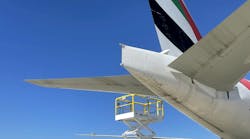Proper maintenance of ground support equipment (GSE) is necessary to ensure ground service providers are operating economically, turning aircraft around efficiently and contributing positively to on-time departures.
However, the most effective way to perform GSE maintenance – and whether it should be done by an operation’s own mechanics or outsourced to a third-party maintenance provider – can differ depending on a number of variables.
The costs and analytics to consider when examining GSE maintenance rely primarily on labor costs, overhead for the maintenance shop and management of the process and employees, explains Jason Gendron, president and CEO of Mercury GSE.
“Direct costs relate to rising labor rates, employment taxes, insurance and supply chain for parts related to GSE,” he says. “Mercury is seeing an increase in requests for outsourcing of maintenance requested from new and existing Mercury customers from airlines, cargo operations and ground handlers looking to reduce the maintenance capEx on their fleet.”
Wayne Ingle, senior vice president of operations for PrimeFlight Aviation Services, suggests beginning by looking at the overall cost comparison between insourcing and outsourcing GSE maintenance. That often starts with the real estate footprint that would be required to effectively maintain a fleet, as the availability of real estate in certain airports is extremely limited, he says.
“Once you have reviewed the real estate investment and availability, you’ll want to consider if you will need maintenance hours or operational coverage hours, and if you need dedicated or fractional labor,” Ingle adds. “What is the workload to effectively manage your fleet? With the current labor market conditions, hiring skilled mechanics can be both difficult and costly, so ensuring you are taking this into account, if this isn’t a position your team typically hires for, is important.”
When it comes to indirect costs, Greg Manny, SVP of operations at Xcēd, says it is important to factor the cost of maintaining a piece of equipment compared to the GSE unit’s value.
“At Xcēd, we track monthly maintenance costs versus the depreciated value, fair market value, etc., of a specific piece of equipment, ensuring we do not spend more than what the market value of the equipment is at the time,” he says. “We also look for trends in parts and maintenance on units to proactively dig deeper into issues before they become major, more costly problems.”
In addition to the maintenance, itself, investing in maintenance systems can produce an indirect cost for a GSE maintenance provider.
“Everything is starting to get more complex. You need systems for everything. You need to digitalize everything,” says Bruno Vanpoucke, group head of commercial at TCR, “So, you need to invest in a maintenance management system, which is typically costly, in order to do those.”
Other difficult-to-quantify costs include insurance, variable fleet sizes, contract management and branding. Additionally, Vanpoucke notes advanced training can add to indirect maintenance expenses. Training is becoming even more imperative as the GSE industry adopts the latest electric vehicle technology.
“It’s a complete shift in terms of the type of people. Typically, you need less people but higher skilled people who cost much more on a per-hour basis,” Vanpoucke says.
While GSE maintenance costs don’t vary much for airlines, ground handlers and FBOs, each group, company and operation may have varied, allowable out-of-service levels and fleet ages, which can drive differences in cost of maintenance, explains Ingle.
Union labor can have an impact on GSE maintenance costs. For example, airlines can sometimes bear the brunt of labor costs associated with GSE maintenance, Gendron says, noting the higher costs of union labor, depending on the location of the airfield. He says a bulk of major airports will have higher direct costs than an outlying airfield operation that is non-union.
“FBOs tend to be non-union and have a smaller fleet of ground support equipment to contend with,” Gendron adds. “Ground handling operations face the same challenges that airlines and large cargo operators face.”
By utilizing new or like-new rebuilt GSE and maintenance services, ground service providers can save money and mitigate downtime.
“The differences for each operation really depend on the size and age of the fleet and the amount of labor overhead needed to keep up with breakdowns and repairs,” Gendron says, adding airlines are experiencing the greatest challenge with the factors of a limited supply chain for parts, labor shortages and rising fixed costs.
Different equipment operators use GSE at varying intervals. So based on the usage of equipment, maintenance requirements can also vary.
“Heavily used equipment will require more maintenance attention as opposed to lower used equipment. However, performing the required preventative maintenance at the correct intervals mitigates major breakdown events and allows the users to control and plan for costs,” says Manny.
Staffing Challenges
According to Vanpoucke, labor availability, including skilled technicians, has decreased due in part to the COVID-19 pandemic.
“They were already a scarce resource, but even more so post-pandemic. A lot of these people with technical skills are in high demand in a lot of other sectors,” says Vanpoucke. “So, it becomes harder and harder to find these people. Then you’ll obviously have a typical supply/demand effect where the salaries go up and the costs go up.”
The labor shortage can lead to difficulties with in-house GSE maintenance depending on the scale of the operation.
“When fractional labor is all that is required, but the coverage of hours needed is widespread, operations need to look at how best to maintain labor efficiencies while not negatively impacting the health of the fleet or the operation,” adds Ingle.
While having experienced staff is always a major plus to have on your side, Manny notes the current market conditions for GSE mechanics are difficult, at best. What’s more, the lack of experience often leads to mistakes in critical decisions resulting in higher costs.
“As the industry stabilizes again, we are confident good career opportunities for new mechanics will return and the process of building experience will improve,” Manny says.
To combat current staffing levels challenges faced by airlines, ground service providers and FBOs, Gendron says Mercury GSE has added recruiting staff to its human resources operations to remain fully staffed with quality mechanics. This has resulted in more operational GSE.
“In one case, a Tug tractor had been flooded in a rainstorm and had water in the fuel tank. No one checked for that, and we were able to get it back in service quickly even after airport techs had given up on it. This was likely related to short staffing, the hiring of less skilled labor and no available training of new techs by the manufacturers in the current environment,” he says, adding Mercury runs through a thorough inspection process before sending out an asset on rent and keeps accurate maintenance records to improve uptime.
GSE shops must continually train on new technologies and keep track of what is going on with different asset types. For example, Gendron says assets such as cargo loaders are complex and technicians with specific cargo loader experience are becoming more difficult to find.
“The key is to measure aptitude of techs and train them in the right way to repair and maintain the assets,” he says. “We often send techs to training courses at the manufacturers, however, that was dampened by the COVID-19 pandemic. There are video trainings and video tech courses that can be utilized. The internet is a powerful tool.
“I would say that keeping up to date and constantly improving your skills as a maintenance technician either on your own time or through an employer is relevant to stay competitive in today’s environment,” Gendron adds.
“Depending on the type of GSE your operation requires, you may need OEM direct training and specialty training on equipment such as deicers, refueling equipment and some cargo equipment,” points out Ingle.
“Most OEMs offer virtual training and since changes in technology are ever changing, getting the most up-to-date training on techniques, common problems, and their solutions, while introducing your staff to new challenges all build up to a more experienced and efficient shop,” Manny says.
In addition to initial training, there is a constant need for training related to troubleshooting new systems that relate to emissions control, on-board computers and electrical systems, Ingle adds.
“It’s important to have a strong training program as well as focus on continued learning and development,” he says.
Training, particularly recurrent training, keeps everyone on the same page and leads to a more knowledgeable staff.
“Continuous learning also keeps individual drive and ambition at a high level,” Manny says. “The more training a mechanic has, the more opportunities to succeed and improve their careers is available. We can’t stress the importance of training enough.”
While some technicians may specialize in hydraulic repair or electrical work, Vanpoucke says TCR places a focus on all-around technicians that may specialize in certain types of equipment.
“We try to organize around families that are kind of similar and have people become experts in those machines so they can troubleshoot in the best possible way,” he says. “There it’s really about keeping them up to date about the machines and the new features, etc.
“All of these machines are electrifying,” Vanpoucke continues. “All of these people, in order to be able to work safely, they need to be accredited for high-voltage maintenance. That’s something we’re investing a lot in because that’s going to be key in order to keep the maintenance safe and guarantees on assets as well.”
Pros and Cons
There can be positive takeaways from performing in-house GSE maintenance as well as outsourcing these tasks.
“People can have a sense of control, or more direct control, if you keep it in house because you are steering everything. But that obviously comes at a cost of managing that and timing that,” says Vanpoucke. “Whereas with an outsourced solution, it’s more about ease of mind and obviously the prime goal in the end is reducing the total cost of ownership of your fleet. Otherwise, you wouldn’t do it.”
When it’s appropriate for an operation to outsource GSE maintenance, the benefits can be endless, including cost savings, according to Ingle.
“Specialized GSE maintenance providers can also help when there is a need to overcome real estate shortages, navigate labor market challenges or leverage fractional labor,” he says.
“If GSE maintenance is a core competency, you gain the ability to control your own assets and out of service times,” Ingle continues. “Depending on the fleet size of your operation, and the expertise of your team in overseeing and managing GSE maintenance operations, you may also be able to find cost savings, improved service levels and added visibility.”
Outsourcing may be a better choice to maintain a company’s ability to stay flexible during growth spurts, says Manny. Not having the costs associated with starting a new shop allows for faster start-ups and in the event a route does not work, helps when a provider needs to move.
“Usually, the labor and other costs of contracting with a third party shop may be slightly higher, but the ability to remain nimble often outweighs those costs,” Manny says. “If you know a station is well established and the workload is consistent, it may be better to in-source maintenance. Providing a stable work environment for in-house staff leads to better quality work and less turnover. High turnover is very costly, so in-sourcing could lead to substantial savings and a better workforce.”
Officials at Mercury GSE have seen the benefits of conducting maintenance both ways and believe that the decision should be made not just by the numbers but by reliability assessment.
“This should be a decision that is made asset specific. What I mean by that is that you can have a hybrid system that leases the more complex, critical assets – cargo loaders, heavy tractors, GPUs, etc. – on a full-service maintenance basis while having an in-house shop that can conduct basic maintenance and repair tasks on less critical and complex assets,” Gendron says.
In order to accurately assess its in-house maintenance capabilities, it is most important to review the current cost of a fleet’s maintenance side-by-side with the service levels provided, advises Ingle.
“Is your fleet being maintained proactively? Is there any negative impact to your operations as a result of fleet maintenance?” Ingle says. “We also can’t ignore the current labor market, and the difficulties and increased cost of both hiring and retaining talent.”
Training on the equipment must be the primary focus of in-house maintenance, Gendron emphasizes. While many technicians come to the airfield with some sort of broad experience, they can also exhibit bad habits.
“Standardizing the maintenance process and documenting processes is paramount to successful uptime and keeping the process moving forward. It also allows for someone to step in and duplicate what has happened with that unit,” Gendron says. “Documentation must be precise and analyzed in order to run a lean, successful maintenance operation.”
The parts costs associated with maintenance of equipment must all be assessed to determine whether outsourcing is the right choice, and parts supply and timing must be evaluated as well.
“Knowing your annual parts spend and what you need in stock for each asset category is crucial. In larger fleets this requires a parts manager or specialist, which is additional overhead,” Gendron says.
In some cases, a ground service provide may keep some maintenance tasks in house and outsource other maintenance work. Occasionally you can have a situation where either due to staffing shortages or skill levels GSE maintenance could be outsourced, Gendron says.
“There are instances where handlers with their own shop farm out maintenance issues on a case-by-case basis to third-party providers,” he adds.
“Looking for specialized services while keeping costs lower or flat when performing maintenance outside of your expertise is something to be considered,” says Manny. “For example, ground power units can be difficult to repair and maintain. If your staff are experts on engine repairs, but weak on generator repairs, looking for an experienced gen shop would help to get the best overall maintenance process for a GPU.”
Having technicians working within their areas of expertise can result in improved and timelier maintenance.
“Each shop is different even within the same company,” Manny adds. “Airports are also different and often do not have space for ground handlers to have their own shops at every location.”
When an operation requires maintenance for both a motorized and non-motorized fleet, or when an operation requires specialized assets, a combination of insourced and outsourced maintenance may be utilized.
“It is very common for a provider to look at their maintenance needs on an airport-by-airport basis due to the differences within each market, including fleet size, fleet complexity, labor market and number of other factors that may drive the complexity of a maintenance operation,” Ingle notes.
The scale of an operation can play a role in making maintenance decisions.
“For example, you’re in a station and you have such a big operation and there’s two workshops available and you cannot fit everything into one – and one is your own workshop and the other is an outsourced workshop,” points out Vanpoucke. “In some stations we’re not present and the scale is just too small to start up, so they keep that in-house at that smaller station.”
However, Vanpoucke adds, having two or three maintenance providers within one station may not be ideal because maintenance may be conducted using different systems and provide varying dashboards and key performance indicators (KPIs).
“And then you typically end up having a lack of visibility,” he says. “That’s the thing you often want to achieve. If you want to go with an outsourced provider, especially across families or across stations, is to be able to get the same data from your fleet everywhere.”
Outsourcing Maintenance
If outsourcing GSE maintenance is the right choice for an operation, Gendron suggests managers talk to others in the industry about their experiences and ask for references; seek advice from industry associations and trade shows when seeking out a third-party maintenance provider.
“Start with a basic snapshot of your maintenance needs and your satisfaction with your current maintenance provider, whether that’s your internal team or an external provider,” adds Ingle. “You’ll want to review everything from your current labor levels and if they are meeting your needs, the location of the shop in relation to your operation, the hours of operation needed and the age and type of fleet you have.
“All this should be clearly defined to ensure you pick a provider that best meets your needs,” he continues. “When reviewing providers, you will want to look at their fit with your needs, their track record within the market and the total cost of service.”
According to Vanpoucke, making clear agreements with a third-party maintenance provider up front is key for success.
“Going to an outsourced solution and keeping it entirely ad hoc and variable and just saying, ‘Look, I’ll bring my machine in when I want and just tell me how many hours it will be and give me an invoice.’ That’s not the way to go,” Vanpoucke says.
“If you want to go for an outsourced solution, you have to do it in a partnership mentality and allow for long-term visibility because then you allow the party to invest in tooling and people, etc.,” he continues. “If the engagement or the contract is very ad hoc, very short term, it typically doesn’t end up with the added values we want to go for. The contracting side is quite important as well.”





